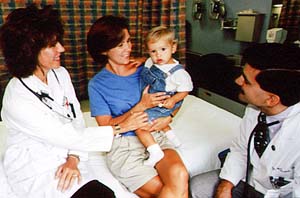School of Medicine researchers found that a child’s age at the time of respiratory syncytial virus (RSV) infection and whether the child lives with a smoker could mean the difference between the sniffles and the intensive care unit.
By 2 years of age, 95 percent of all children have been exposed to RSV, but symptoms can range from a mild cold to serious pneumonia.

For more than five years, researchers have been following 206 children since they were treated in the St. Louis Children’s Hospital Emergency Department.
The infants all were under 12 months and had a wide range in severity of RSV infection when they were enrolled in the RSV Bronchiolitis in Early Life (RBEL) study.
Principal investigator Mario Castro, M.D., associate professor of medicine and of pediatrics, and his colleagues looked at medical records and measured the children’s oxygen saturation levels during RSV infection.
The lower the oxygen saturation, the more serious the infection. Later, they went to the children’s homes and analyzed dust and allergens to determine their role in the severity of RSV infections.
Researchers asked the mothers detailed questions about their pregnancies, including whether or not they smoked cigarettes either before or after giving birth. They also asked the mothers about their allergy and asthma problems.
“What we’re trying to study isn’t the likelihood of getting the disease, because it seems just about every kid gets RSV,” Castro said. “We wanted to learn what factors are driving the severe, life-threatening infections.”
Not surprisingly, one of the most important risk factors for severe infection was exposure to cigarette smoke.
“Smoking in the household is really detrimental,” Castro said. “The kids who lived with mothers or others who smoked developed more severe RSV infections than kids who were not exposed to cigarette smoke.”
Twenty-eight percent of the children in the study lived with a mother who smoked, and a total of 40 percent lived in a house where at least one person smoked. All of these children had more severe infections.
But surprisingly, cigarette smoking during pregnancy did not seem to increase the risk of severe infection.
“It’s a great thing not to smoke during pregnancy,” he said.
“But it’s equally important not to smoke after pregnancy. Kids spend a lot of time with their mothers during the first few months of life, and it’s detrimental to the child’s health if their mother is smoking.”
Age is another risk factor for serious RSV infection: the younger the child, the more serious the infection.
Castro attributes that risk increase to lung and airway development. Tiny windpipes can become clogged with mucous and other secretions more easily than bigger, more developed airways.
The researchers also measured levels of pet, dust and cockroach allergens, all of which have been linked to allergy and asthma problems.
“We found that even in the kids who came from the homes with the highest allergen levels, there was no increased risk of RSV,” Castro said.
Mothers with allergies or asthma also seemed to have a protective effect, and their children tended to have less serious RSV infections, which is surprising, according to Castro, because the virus has been linked to asthma risk later in life.
“We believe the severity of initial RSV infection has a role in increasing the risk for asthma later in childhood,” Castro said. “But we won’t know for sure until the children get older.”